Analysis of Cationic Polymers by Size Exclusion Chromatography (SEC)
The Application Notebook
Regina Roemling,1 Kuniyuki Tokunaga2 and Hiroyuki Moriyama,2 1 Tosoh Bioscience GmbH, Stuttgart, Germany,
2 Tosoh Corporation, Tokyo, Japan.
Cationic Polymers
Water soluble cationic polymers can be designed with performance profiles for a broad range of different application fields. They are used in detergents and cleaners, as coagulants and flocculating agents in the paper industry and wastewater purification as well as in many technical applications. Another application field is the cosmetics industry, where cationic polymers are used in hair shampoos as conditioning agents.3
Cationic polymers based on ethyleneimine (PEI) exhibit a strong and permanent binding to surfaces, they are exceptional adhesives. As a result they can be used in a variety of applications such as coatings, as primers for polymer compounds in film formation and for surface modification in dyeing of plastics. Polyallylamine (PAA) and other polyamine copolymers are used in the coating of textiles to prevent colour fading.4 Cationic dextranes, polyethyleneimines and polylysines are used for transfection of cells or for drug delivery because they form complexes with nucleic acids like DNA or siRNA.5 The behaviour and efficiency of cationic polymers for a certain application is based upon the size and characteristics of the individual polymer.
Aqueous Size Exclusion Chromatography
SEC combined with multi-angle laser light scattering (MALLS), refractive index or viscometric detection is a common means for the characterization of polymers. The challenge in SEC analysis of cationic polymers is the potential interaction of the highly adhesive polymers with the column packing. This impairs peak shape and molecular weight determination.6 With most SEC columns the undesired interactions are suppressed by using a mobile phase with a high salt content, bearing the risk of precipitation and low recovery.
A new type of SEC column was developed to overcome the need of high salt eluents in SEC determination of water-soluble cationic polymers. TSK-GEL PWXL-CP columns are based on the well known PW-type of polymeric resins for aqueous SEC. The surface of the polymethacrylate base material was modified by incorporating a cationic functionality. This modification results in high recovery of cationic polymers and enables elution under low salt conditions. The columns show high theoretical plate numbers, linear calibration curves and high durability. They are produced with three different pore sizes resulting in different separation ranges.
Low Salt SEC Analyis with TSK-GEL PWXL-CP Columns
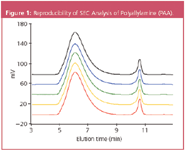
The high reproducibility of SEC separations of cationic polymers on TSK-GEL PWXL-CP columns was demonstrated by repeated injection of a high molecular weight polyallylamine (PAA). PAA (MW 438000) was injected onto a TSKgel G5000PWXL-CP column and analysed at 25 °C using a mobile phase containing 0.1 M NaNO3. Figure 1 shows the high reproducibility of the SEC analysis without any adsorption of the polymer. The recoveries of the PAA polymer were measured as well. High recoveries of more than 97% were obtained with all three types of TSK-GEL PWXL-CP columns.
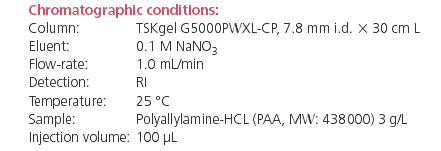
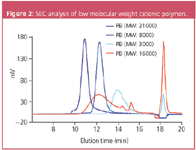
The analysis of different low molecular weight polymers of allylamine (PAA) and ethyleneimine (PEI) can be performed by combining two of the TSKgel G3000PWXL-CP columns in series (Figure 2). The TSKgel G3000PWXL-CP column has the smallest pore size in the series of SEC columns for cationic polymers. The use of two columns in series provides a very good separation of the three PEI polymers with molecular weights of 3000, 8000 and 21000 respectively. PEI is of special interest as a powerful non viral gene-transfection agent, which condenses nucleic acids by ionic interactions.
Figure 3 shows the elution profiles of a variety of cationic polymers with different functional groups. For this application the three types of TSK-GEL PWXL-CP were connected in series. The polymers elute in the expected order of their molecular weight demonstrating that there was no influence of the type of functional group. There was no ionic interaction observed which was interfering with the size exclusion mode.
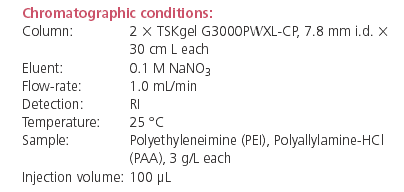
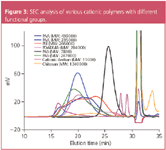
The data presented in this application note shows that the new type of SEC columns can be used for the analysis of a variety of aqueous cationic polymers. The recoveries of the cationic polymers were excellent on each grade of the new columns, thus demonstrating that these columns will be valuable to both QC and polymer research laboratories. They provide an improved tool for researchers in the different application fields of cationic polymers ranging from applied chemistry to drug delivery and genetic engineering.
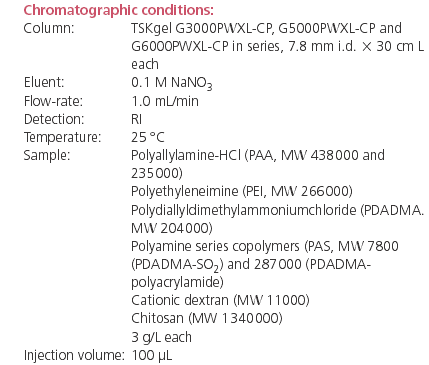
References
1. M. Liu et al., J. Chromatogr. A, 1104(1–2), 145–153 (2006).
2. X. Jiang et al., Pharmaceutical Research, 23(3), 595–603 (2006).
3. C. U. Patel, Int. J. of Cosmetic Science, 5(5), 181–188 (1983).
4. S. Rosunee et al., J. of Material Science, 38(10), 2179–2185 (2003).
5. Th. Merdan et al., Advanced Drug Delivery Reviews, 54(5), 715–758 (2002).
6. B. Wittgren et al., J.Chromatogr. A, 1002, 101–109 (2003).

Tosoh Bioscience GmbH
Im Leuschnerpark 4
64347 Griesheim
Tel: +49 6155-7043700
Fax: +49 6155-8357900
Info.tbg@tosoh.comwww.tosohbioscience.de
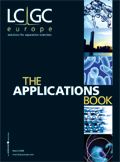
The Benefits of Custom Bonded Silica
April 1st 2025Not all chromatography resins are created equal. Off-the-shelf chromatography resins might not always meet the rigorous purification requirements of biopharmaceutical manufacturing. Custom bonded silica from Grace can address a wide range of separation challenges, leading to real performance improvements. Discover more about the latest innovations in chromatography silica from Grace, including VYDAC® and DAVISIL®.
5 Things to Consider When Selecting a Chromatography Silica
April 1st 2025Particularly in the pharmaceutical industry, drug purity isn’t just a goal – it’s essential for achieving safety, stability and efficacy. However, purification is easier said than done, especially with challenging molecules like DNA and RNA “oligonucleotides,” due in large part to their diversity and the range of impurities that can be generated during production. Enter DAVISIL® chromatographic silica, with a wide range of pore diameters and particle sizes to meet your specific application, performance and sustainability requirements. Before you choose the chromatography resin for your next purification application, take a look at these 5 considerations.
Automating Protein Purification: Efficiency, Yield, and Reproducibility
March 27th 2025Recent advancements in automated protein purification stress the importance of efficiency, scalability, and yield consistency. This eBook compares different purification platforms, highlighting their impact on downstream applications and demonstrating how automation enhances throughput and process control.
MilliporeSigma: Ultrapure Water for Sensitive LC-MS Analysis of Pesticides
March 25th 2025The aim of the study was to illustrate the efficiency of Milli-Q® water purification systems in eliminating pesticides from tap water, thereby producing and delivering reliable and consistent-quality ultrapure water suitable for pesticides analysis




